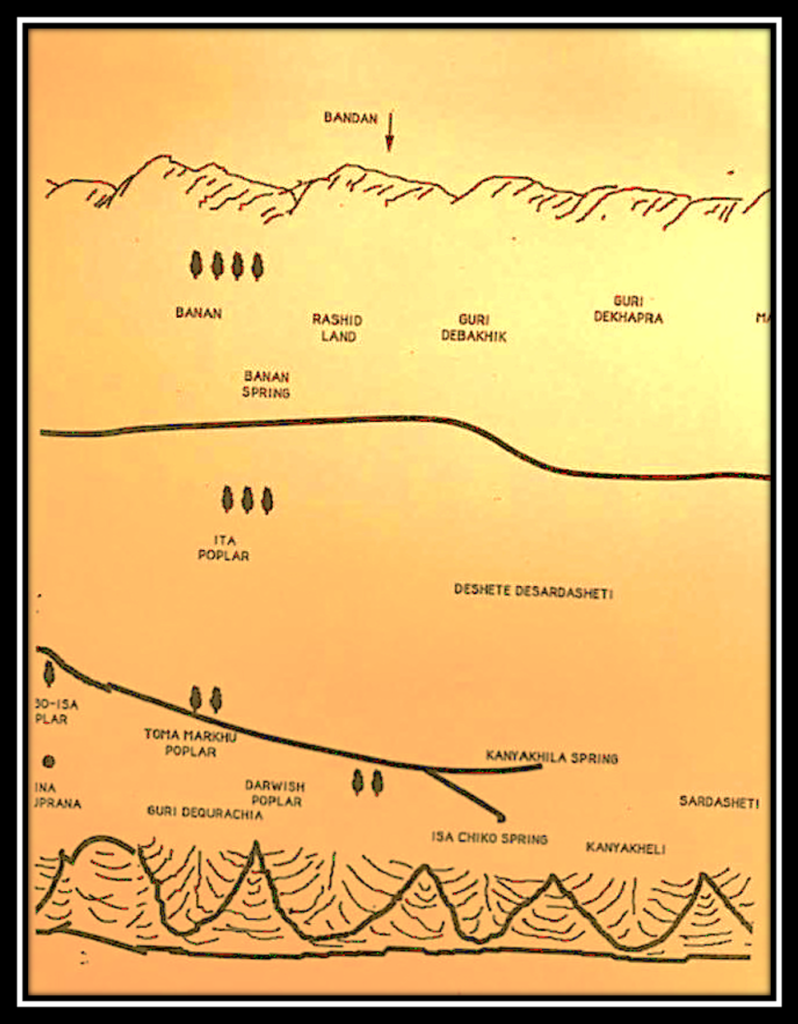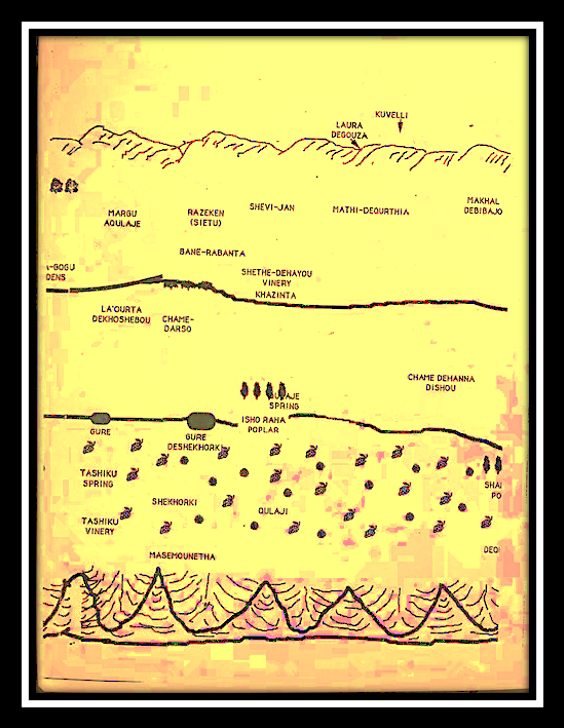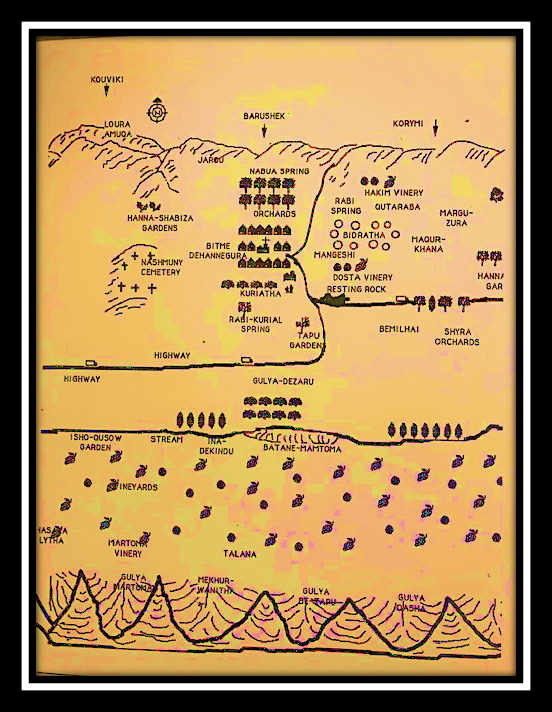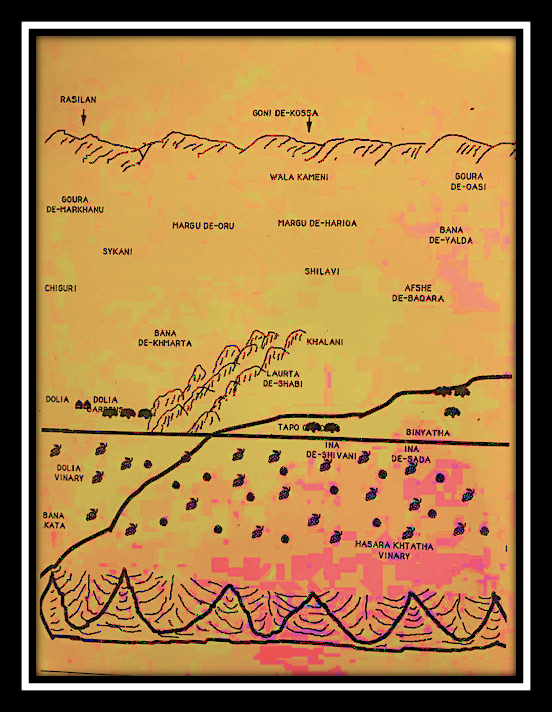MANGESHI REALTY
MANGESHI REALTY
By: Francis K. Khosho
Mangeshi village is in northern Iraq, part of the Dehuke governorate in the region of Kurdistan. Back during my time there, people from the area would typically sustain themselves through cattle breeding and farming. That is why I often say my childhood memories all seem to be captured through a farmer’s lens. The landscape of our village Mangeshi, the light of my eyes, is a reflection of our identity over many years. It serves as a strong link between its past and present and shining proof of its authenticity.
Mangeshi has been able to maintain its ancestral heritage through the preservation of countless traditional landmarks. Many are still referred to by their original names which are connected to historical mythology and form much of the basis of our cultural heritage. We must continue to fight for their conservation as they remain the strongest link between our collective memories and our homeland.
The landscape of Mangeshi serves as a profoundly distinct recollection for all who descend from this village. For example, the Mangeshi mountains to the south of the village, which stretch from east to west, are steep and picturesque. They boast almost equal peaks which rise above the surrounding area, and provide an incredibly breath-taking view. The peaks are gradually separated with similar ridges (Kalyatha). The mountains house many hermitages (Qalayath) and caves. These hermitages are thought to have existed back during the early form of “pro-monasticism” in the third century among Syriac speaking Christians. Monks dwelled there and choose to live their life in prayer and contemplation, separated from the rest of the world.
Another unique draw is the Mangeshi plain, a sweeping landmass that does not change in elevation and stretches for miles. The soil is incredible and richly fertile, making it suitable for vineyards. Vineyards in Mangeshi also stretch from east to west, from Sardashti to Dolayi vinary. They include: Sardashti vineries, Kanyakheli vineries, Guri D’ Qarachayi vineries, Ina D’ Qoprani vineries, Qalaji vinaries, Shekhorki vineries, Tasheku vinaries, Talana Vinaries, Qa Matha (Mar Toma) vineries, Hasari Lytha vineries, Hasari Khtetha vineries (Hasari vineries were planted in 1945 according to Aunt Kato Odo Dawoth) and the far east Dolayi vineries. Also, to the middle and north of Mangeshi, there are vineries in Shethi De Hayou, close to Khezenta, Karmani Be Hakim (also known as Karmani D’ Nabo’a) by Qata Raba, B’ Dosta vinaries by Restingstone (Qatar D’ Manikhani) and Karmani D’ Bathri Zoori (close to Koremi). The grapes played an important role in the Mangeshi diet, particularly in their dried form (Yabeshi). The Mangeshi river valley soil was good for growing food crops and poplar trees (Khoryatha) such as Toma Markhu poplar, Shabo Isa poplar, and Isho Rahi poplar. Also, there were many gardens by Guri De Qurachia, Ina De Qoprana, Qulaji, Shekhoki, Tasheku spring, Gura, Kenyatha polis Dano, Guly de Zarro, Ina Dekindu, Isho Qosow garden, Bi Tersha, Ina Sadi, Ina De Shivani, Be Tappo gardens. Inland fields with their bountiful water sources, allowed for the growth of vegetables, tobacco and fruits: Mathi D’ Qorthayi, Ina D’ Mekha Quso, Laorta D’ Khoshebo, Margi D’ Qlech, Kenthi Nanoki, Hana Kuki gardens, Marka Zora, Qata Raba, Kenyatha Be Rabi, Koza, Nabo’a, Shaqetha, Kharethwani D’ Matha, B’ cherko gardens, B’ Tappo Gardens, Rabi Koriyi garden, Betersha, and Hana Shabesi garden.
The northern part of Mangeshi resembles a long line of rolling hills. These gentle hills are neat and wooded with oak trees and bushes (Serdi). They are covered with grass, lush green valleys and verdant meadows with wild flowers. Guri De Khapri by Marjomakhti, and Guri de Bakhik would be covered by grass during the spring. The grass was cut and dried, and stored for use as animal feed (Patheli). The gentle hills, rolling plains and valleys provided ample space for agriculture and were ideally appropriate for growing wheat barley and lentils. These were planted in early spring and harvested in late summer. Some good wheat stands were Guri De Bakhik, Banan, Laura De Kuza, Shevijan, Margu De Aqlaje, Razeken, Bana Rabanta, Marga Zora, Qata Raba, Qokhta, Qwari De Samano, Zori, Laura Amoqa, Qwari Be Oasi, Bathri Jaro, Bana D’ Yalda, Afshi D’ Baqara, Margi D’ Hareqi, Shilavi, Marga D’ Oru, Sykani,Chigori, and Bana D’ Khmarta. Khalani was an area of highland with soil that was not good for growing crops. The ground was rocky, and could only sustain evergreen dwarf pine trees called Daprani. It was problematic not just because the pine trees made it challenging but because the rocky, sandy soil had fewer nutrients than other soil and held water poorly.
Below, I have included and unscaled sketch map of Mangeshi. I am honored to say that in my childhood and younger years I had the opportunity to touch, walk on and explore the treasured realty of Mangeshi. Every season I had the fortune to listen to the distinct sounds made upon it – wind, rain, and snow – and got to witness all the creatures that lived amongst us. I keep my beloved Mangeshi village forever in the mind and reminisce often about its beauty. My hope is that some of these landmarks have sparked a particular memory for you, and that together, we will continue to support their preservation.




الطبيعة حواليّ منكَيشي
بقلم :فرنسيس ك. خوشو / ساندييكَو
ترجمة من الأنكَليزية: حنا شمعون / شيكاغو
تقع قرية منكَيشي شمال العراق، وهي تابعة لمحافظة دهوك، في منطقة كردستان.. وخلال الفترة التي قضيتها في هذه القرية كان سكان المنطقة يعتمدون على تربية المواشي والزراعة.ولذا انظر الى طفولتي من منظار الزراعة. الطبيعة (آقر) حواليّ قرة عيني منكَيشي عكست هويتي الأصيلة منذ ذلك الحين وعلى مدى طويل لتربط الحاضر بالماضي.
صانت منكَيشي تراث الأجداد من خلال الحفاظ على المواقع الطبيعية العديدة المعروفة، والتي كثير منها مازالت تعرف بأسمائها الأصلية والتي بعضها مرتبط بالأساطير التاريخية وبذا فان هذه القرية حافظت تراثها الثقافي. وعلينا نحن ايضاً الحفاظ على هذه التسميات لتبقى رابطاً قوياً يشد ذكرياتنا الى موطننا الأصلي.
كل الذين منشأهم منكَيشي يرون ارتباطهم العميق بهذه القرية من خلال ذكرياتهم المميزة بالطبيعة التي حواليّ قريتهم. مثلاً جبل منكَيشي الذي يقع جنوب القرية والذي يمتد من الشرق نحو الغرب. شكل هذا الجبل يفتن البصر فقممه تتوزع على خط مستقيم وبنفس العلو تقريباً ونحو المنحدر تتوزع الكًلياثا على نفس المنوال. وتنتشر الصوامع ( القلاياثا) والكهوف في كل ارجاء الجبل . الصوامع هذه يعود تاريخها الى عهد نشوء الرهبنة في المنطقة التي سكنها المسيحيون المتكلمون بالسريانية وذلك في القرن الثالث الميلادي. سكن الرهبان في هذه الصوامع ليعيشوا حياتهم الخاصة المنعزلة عن بقية العالم.
شكل آخر للطبيعة التي حواليّ منكَيشي هو السهل الممتد لعدة اميال موازياً لسفح الجبل حيث التربة خصبة جداً فتكون مؤهلة لزراعة كروم العنب التي تمتد من سردشتي شرقاً الى دولايي غرباً حاويةّ الكروم التي تسمياتها: كنيخيلي، كَرا دقرجاي، اينا دقوبراني، قللاجي، شيخوركي، تشيكو، طلانا، قم ماثا ( مار توما) ، حساري ليثا، حساري ختيثا، وهاتين الأخيرتين والى الغرب منها الى ان نصل دولايي منهما أنشئت كرومها عام 1945 ( حسب ما ذكرته العمة كتو اودو داوث).
وكذلك توجد كروم اخرى في الغرب والشمال الى القرية وهي: شيذي دحيو، القريبة من خزينتا، و كرماني دحكيم المعروفة باسم كرماني دنبوؤ بالقرب من قاطا رابا، وكذلك كرم داوستا عند قطرا دمنيخاني، اضافة الى كرماني دبثر زوري القريبة من كرويمي.
العنب كان له دور ريادي في غذاء المنكَيشيين، وخاصة المجفف منه المعروف باسم يبيشي.
التربة التي تقع الى الشمال من نهر منكَيشي الصغير كانت صالحة للمحاصيل الزراعية وزراعة اشجار الحور ( خورياثا) وهذه الاراضي تشمل خورياثا د توما مرخو ، شابو عيسى، ايشو راحي.
وكذلك هناك عدة جنينات( كَنياثا) في المناطق التي تسمى :كَرا دقرجاي، اينا دقوبرانا، قللاجي، شيخوركي، اينا دتشيكو، كَرّا، بولص دنو، كَلي دزرو، اينا دكيندو، ايشو قوسو، بيطرشا، اينا دسهدي، اينا دشيفاني، و بي تبو.
اما المنطقة الداخلية والمحيطة بالقرية حيث الينابيع المتعددة ففيها البساتين التي تزرع فيها في الغالب الخضراوات والتبغ والفواكه وهذه البساتين هي: ماثا دقورذاي، اينا د ميخا قوسو، لأرتا دخوشيبو، مركَا دأقلج، كَنثا دنونكي، كنثا د حنا كَوكَي، مركَا زورا، قاطا رابا. كَنياثا دبي رابي، كَوزا، نبوؤ، شقيثا، خرذواني دماثا، كَنياثا دبي جركو، كَنياثا دبي تبو، كَنياثا درابي كَوريي، بي طرشا، و حنا شابزي.
الجزء الشمالي من طبيعة منكَيشي يمثل امتداد لتلال مترابطة ، وهذه التلال الهادئة المنظمة مكسوة عادة بأشجار البلوط والشجيرات الكثيفة ( سردي) وفي الربيع ينمو الحشيش فيها والمروج الخضراء والزهور البرية لتجف كلها في الصيف وتجمع ويعمل من الشدات المفتولة التي تسمى ( بثيلي)، والتسمية الغالبه لهذه الطبيعة هي كَورّي ومنها كَورّي دخبري قرب مرجومختي، وكَورّي دباخك.
بعض هذه الكَوراثا ( جمع كَوري) لكونها خصبة وذات تربة ملائمة فقد كانت تزرع بالحنطة والشعير، والعدس والخرطمان. وكانت تزرع في بداية الريبع وتحصد في منتصف الصيف ومن هذه الكورّاثا اتذكر: كَورّي دبي باخك، بنن، لورا دكَوزا، شفيجان، مركَا دقلاجي، رزكن، بانا دربنتا، مركَا زورا، قاطا رابا، قوختا، كَوري دسامانو، زوري، لورا اموقا، كَوري دبي اوسي، بثر جرو، باني ديلدا، افشي دبقارا، مركَي دحريقي، شيلافي، مركَا دأورو، سيكاني، شيخوركي، باني دخمرتا.
وبقي الآن ان نذكر عن الطبيعة التي تقع في الغرب من منكَيشي وهي خلاني وهي خالية من الماء والينابع، وهي منطقة شبه منحدر ة وفيها الصخور المرقطة و تربتها رملية وهي غير صالحة لزراعة المحاصيل، فقط تنمو فيها الأعشاب الشوكية وشجيرات الصنوبر القزمية التي تسمى ” دبرانا”.
ادناه مقاطع طولية بغير مقياس الرسم لطبيعة منكَيشي ، واود ان اذكر انه في طفولتي وفتوتي حصل لي الشرف لان المس هذه الطبيعة في كل فصول السنة -مع مصاحبة المطر والثلج والريح، والجو ا لمعتدل، واستمع الى الأصوات المميزة للمخلوقات من دواب وحشرات لاكون شاهد عيان لهذه الطبيعة المميزة بجمالها.
اني لازلت احتفظ برونق تلك الطبيعة الخلابة حواليّ غاليتي منكَيشي في فكري وذاكرتي و في جوانحي الخفية.
املي ان بعض من هذه الاسماء الواردة لتلك المواقع سوف توقظ ذكريات خاصة لديكم، وسويةً سوف نستمر في الحفاظ عليها، لا بل نزيدها جمالاً.
فرنسيس ك. خوشو

